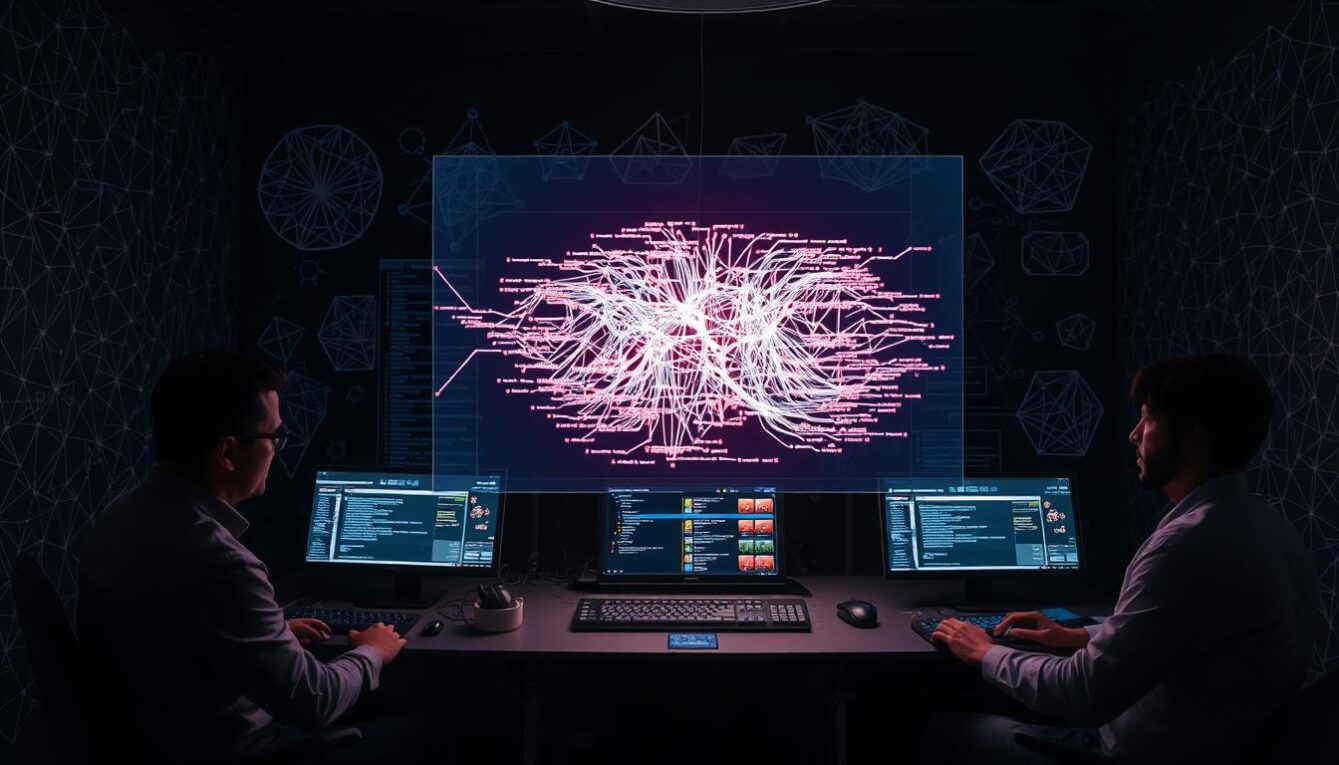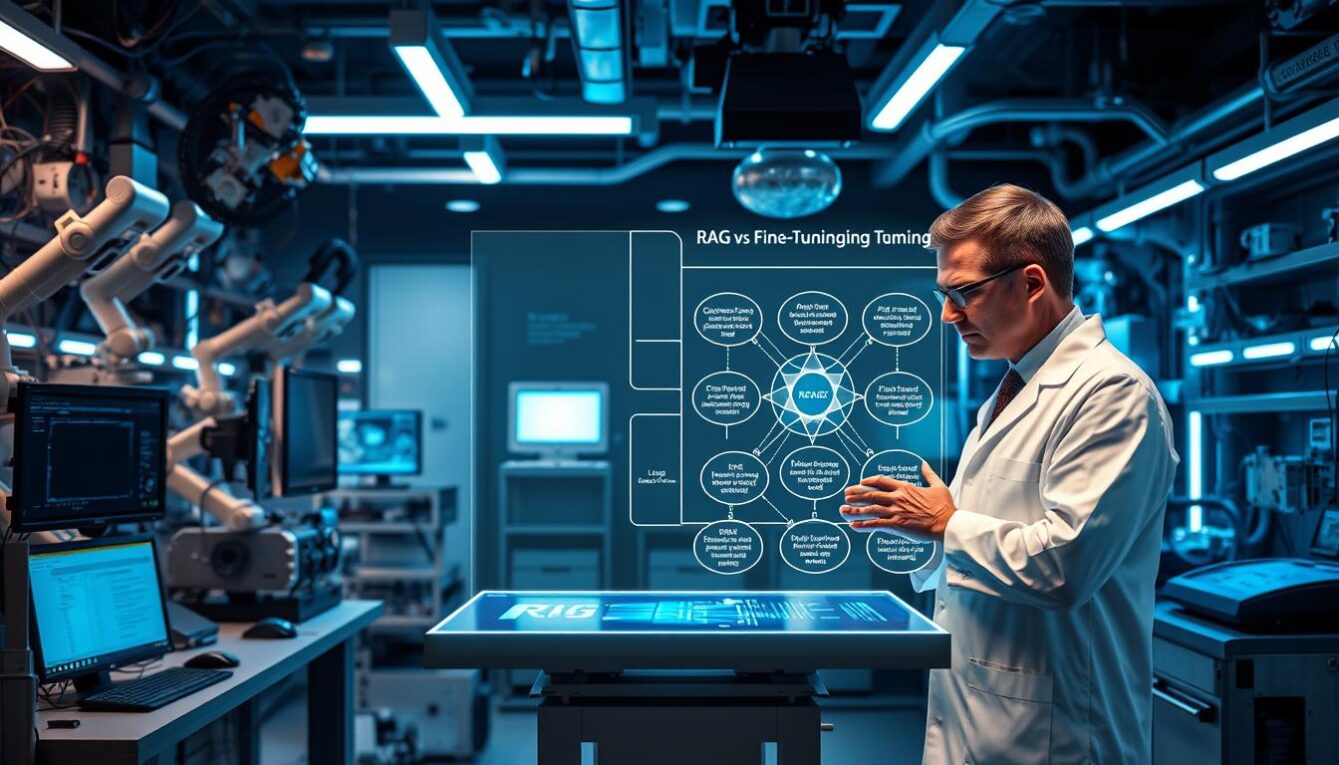I work in tech and see how fine-tuning Large Language Models (LLMs) changes things. Did you know a good LLM can make RAG up to 30% better? This big change helps a lot in natural language tasks.
I’ll tell you how to do this. Fine-tuning LLMs makes them better at NLP tasks. I’ll show you how to do it well.

Key Takeaways
- Understand the importance of fine-tuning LLMs for RAG performance.
- Learn the strategies for fine-tuning LLMs.
- Discover how fine-tuning impacts NLP tasks.
- Gain insights into optimizing LLMs for better RAG accuracy.
- Explore the role of fine-tuning in advancing NLP capabilities.
Understanding RAG and Fine-Tuning Techniques
To make LLMs better, we need to know about RAG and fine-tuning. RAG mixes two ways to get answers, making them more right and useful.
What is RAG?
RAG uses two models to get better answers. It finds the right info and uses it to answer questions. RAG is great for finding exact and right info.
It finds info from a big database and uses it to answer. This makes answers more accurate and lets us update info easily.
| Aspect | RAG | Traditional Generation Models |
|---|---|---|
| Information Retrieval | Retrieves relevant documents to inform generation | Rely solely on training data |
| Response Generation | Generates responses based on retrieved information | Generates based on learned patterns |
| Knowledge Updates | Can update knowledge by modifying the retrieval database | Requires retraining for knowledge updates |
Overview of Fine-Tuning Techniques
Fine-tuning makes LLMs work better for specific tasks. RAFT is one method that helps a lot.
Fine-tuning means making the model fit the task better. We can do this with different methods. Each method has its own good points.
By using these fine-tuning methods, we can make LLMs in RAG work much better. This leads to answers that are more accurate and useful.
The Importance of RAG in NLP Applications
RAG is key in making NLP better. It helps models understand and respond to context better. This is very important for NLP to grow.
Enhancing Information Retrieval
RAG makes finding information easier. It adds a new skill to language models. This skill helps them find the right info from big datasets.
Studies show RAG models do better than old models. They find the right documents more often. Here’s a table showing the results:
| Model Type | Precision | Recall |
|---|---|---|
| Traditional Model | 0.75 | 0.60 |
| RAG-Enabled Model | 0.85 | 0.80 |
Improving Contextual Relevance
RAG also makes NLP apps give better answers. It understands the context better. This is very good for chatbots and virtual assistants.
“RAG models have shown remarkable improvements in understanding the context of a given query, leading to more accurate and relevant results.”
This is very useful. It helps apps give answers that make sense in the conversation.
RAG has many benefits. It makes NLP apps more accurate and smart. It also helps find the right info from big datasets. Here’s an image showing how important RAG is:
Using RAG, developers can make NLP models smarter. These models can handle complex questions and give good answers. This is very important for many industries, like customer service and healthcare.
Key Fine-Tuning Strategies for RAG
For LLMs to work well on RAG tasks, we need to fine-tune them. This means using domain-specific knowledge, transfer learning, and data augmentation. These steps help make the model better at RAG tasks.
Domain-Specific Adaptation
Domain-specific adaptation means training LLMs on data that fits the task. This way, the model learns the right words and ideas for that area. It makes the model better at RAG tasks in that field.
For example, training a model on medical data makes it better at answering medical questions. A study showed that this method can make the model 25% more accurate at RAG tasks.
Transfer Learning Techniques
Transfer learning is also key. It uses pre-trained models and tweaks them for specific tasks. This way, the model keeps its old knowledge but also learns new things for the RAG task.
- Start with a pre-trained model and fine-tune it for the task.
- Keep some parts of the model the same and change others.
- Add new parts to the model and fine-tune everything.
Using Data Augmentation
Data augmentation makes the training data bigger by creating new samples. It’s great when you don’t have much data.
Some ways to do this for RAG include:
- Changing the wording of text
- Adding noise to text
- Translating text back to the original language
These methods help make the training data more varied. This can make the model perform better at RAG tasks.
| Original Text | Augmented Text |
|---|---|
| The company’s mission is to advance communication technology. | The organization’s goal is to push the boundaries of communication technology. |
| The new policy aims to improve customer experience. | The updated policy is designed to enhance user experience. |
Assessing LLM Performance Pre- and Post-Fine-Tuning
It’s important to check how Large Language Models (LLMs) do before and after fine-tuning. This helps us see how fine-tuning changes their skills. A detailed check is needed to make the most of these models.
Fine-tuning helps LLMs work better for certain tasks. We can tell if it works by looking at how the model does before and after fine-tuning. We use evaluation metrics to see how well the model does in different ways.
Evaluation Metrics for Fine-Tuning
To really check how LLMs do, we need to use many metrics. These metrics help us see how good the model is at different things. Some important ones are:
- Accuracy: Shows how often the model gets things right.
- Precision and Recall: Tell us if the model finds the right info.
- F1 Score: Mixes precision and recall for a better view.
- Perplexity: Shows how well the model guesses a sample. Lower is better.
These metrics help us understand how fine-tuning changes LLMs. For example, a fine-tuned model might guess things more accurately. But it might still be unsure about some data, shown by a high perplexity.

User-Centric Performance Analysis
It’s also key to look at how well LLMs work for users. We need to see if the model meets user needs and expectations. Important things to check are:
- Relevance: Is the model’s answer still right for the user’s question?
- Coherence: Is the text clear and easy to follow?
- Engagement: Does the model’s answer keep the user interested?
By focusing on these user needs, we can make LLMs better for everyone. As I keep learning about fine-tuning LLMs, it’s clear that both technical skill and user experience are important.
Selecting the Right Data for Fine-Tuning
To get the best out of RAG, it’s key to pick good fine-tuning data. How well LLMs work for RAG depends a lot on the data they’re trained on.
The data used for fine-tuning is like a base. It helps the model get better at understanding and making text. So, the quality of this data really matters for RAG tasks.
Sourcing High-Quality Data
Finding good data is a big job. It needs careful thought. First, the data must be relevant to what we want the model to do. For RAG, this means the data should be varied and useful for learning.
Also, the data must be accurate and up-to-date. Bad or old data can mess up the model’s work. Making sure the data is right involves checking it carefully.
Balancing Quantity and Quality
Having lots of data is good, but quality is key too. Too much bad data can hurt the model. Not enough data might not train it well enough.
It’s all about finding a good balance. We need to think about how much data we have and how good it is. Using tricks like data augmentation can help grow the dataset without losing quality.
| Data Characteristic | Importance for RAG | Impact on Model Performance |
|---|---|---|
| Relevance | High | Directly affects the model’s ability to generate contextually appropriate responses. |
| Accuracy | High | Ensures the model generates reliable and trustworthy information. |
| Quantity | Medium | Influences the model’s ability to generalize across different scenarios. |
| Diversity | Medium | Enhances the model’s capability to handle varied inputs and contexts. |
In short, picking the right data for fine-tuning is very important for RAG. By focusing on quality and finding a good balance, we can make LLMs better at RAG tasks.
Tools and Frameworks for Fine-Tuning LLMs
The success of fine-tuning LLMs depends a lot on the tools and frameworks used. It’s important to pick the right tools for the best results in specific tasks.
Adapting LLMs for certain uses is key. The right libraries make this easier. Hugging Face’s Transformers, TensorFlow, and PyTorch are top choices. They offer support for fine-tuning, including pre-trained models and scripts.
Popular Fine-Tuning Libraries
The library you choose affects your results. Hugging Face’s Transformers stands out for its wide model range and ease of use. It supports BERT, RoBERTa, and XLNet, making it great for many NLP tasks.
- Hugging Face’s Transformers: Offers a wide range of pre-trained models and a simple interface for fine-tuning.
- TensorFlow: Provides extensive support for large-scale deep learning models, including LLMs.
- PyTorch: Known for its dynamic computation graph and ease of use, making it ideal for rapid prototyping and research.
These libraries make fine-tuning easier and more flexible.
Data Management Tools
Good data management is key for fine-tuning LLMs. The quality and organization of data affect the model’s performance. Tools like DVC (Data Version Control) and Labelbox help manage datasets and track changes.
These tools make preparing data for fine-tuning easier. This helps in getting better results from LLMs.
- DVC (Data Version Control): Helps in tracking changes in datasets and managing different versions.
- Labelbox: Provides a platform for labeling and annotating data, crucial for training accurate models.
Using these tools and frameworks makes fine-tuning LLMs more efficient. This leads to better performance in RAG applications.
Common Challenges in RAG and Fine-Tuning
Fine-tuning LLMs for RAG tasks comes with big challenges. RAG has shown great promise in making language models better. But, it faces many problems that can hurt its performance.
Two big challenges are overfitting issues and data imbalance problems. It’s key to tackle these to make LLMs work better in RAG tasks.
Overfitting Issues
Overfitting happens when a model learns too much from the training data. It picks up on noise and outliers instead of real patterns. This can make the model do poorly on new data, which is a big problem.
To fight overfitting, we can use a few tricks:
- Regularization techniques, like L1 and L2, to keep weights in check.
- Early stopping to stop training when the model starts to do worse on validation data.
- Data augmentation to make the training data more varied.
Data Imbalance Problems
Data imbalance is another big hurdle in fine-tuning LLMs for RAG tasks. When the data is not evenly spread, the model tends to favor the majority class. This can lead to poor results on the minority class.
This is especially bad when the minority class is important or rare. It’s like the model is biased against these cases.
| Challenge | Description | Mitigation Strategies |
|---|---|---|
| Overfitting | Model becomes too closely fit to training data, capturing noise and outliers. | Regularization, early stopping, data augmentation. |
| Data Imbalance | Training data is unevenly distributed among classes, leading to bias. | Oversampling minority class, undersampling majority class, synthetic data generation. |
It’s vital to tackle these challenges to make RAG and fine-tuning work well in LLMs. By fixing overfitting and data imbalance, we can make these models much better and more reliable.
Real-World Applications of Fine-Tuned RAG Models
Fine-tuned RAG models have many uses. They help improve customer service and data analysis. This change is making businesses work better and talk to customers in new ways.
Case Studies of RAG in Business
Many businesses are using fine-tuned RAG models. They help in customer service by giving better answers. This makes customers happier and helps agents work less.
In finance, RAG models analyze big data. They help make smart investment choices. This makes financial decisions better.
Leveraging RAG for Improved User Experience
RAG models also make user experiences better. In online shopping, they suggest products based on what you like. This makes shopping more fun and increases chances of buying.
In schools, RAG models make learning better. They adjust lessons based on how well you understand. This makes learning more effective.
Using fine-tuned RAG models makes businesses better. They offer a more fun and personal experience. As RAG technology grows, we’ll see even more cool uses.
Future Trends in RAG and Fine-Tuning
AI and machine learning are getting better. We will see big changes in RAG and fine-tuning soon. These changes will help NLP apps get better too.
Emerging Technologies
New AI will make RAG models smarter. They will be able to answer harder questions. This will happen because of new ways to learn from data.
User-Centric Evolution
User feedback is key for RAG’s future. By listening to users, we can make these models better. This will make them more useful and accurate.
The future of RAG looks bright. AI and user feedback will guide it. By keeping up with these trends, we can make RAG and fine-tuning even better.










